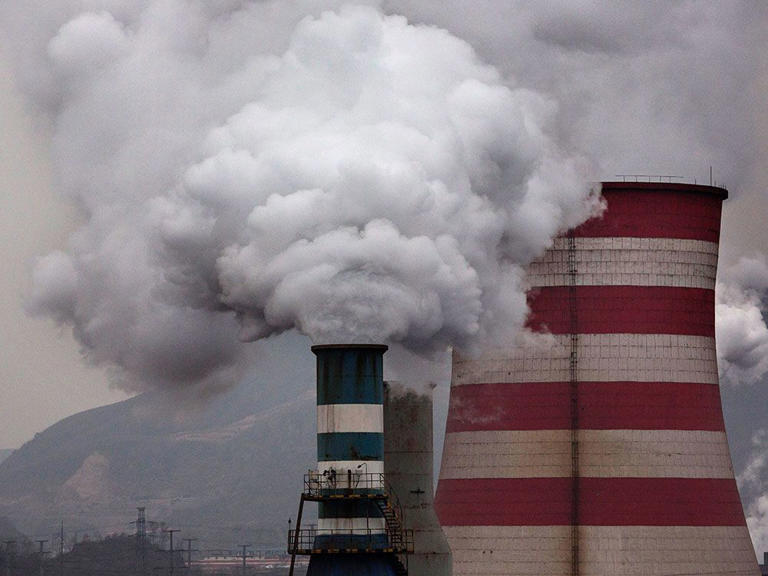Opinion by Special to Financial Post •

Emissions in less developed countries continue to grow rapidly.© Kevin Frayer/Getty Images
By George Fallis
More than 30 years after the countries of the world first came together to fight climate change it is time for a clear-eyed look at where we stand and what lies ahead.
Fully 154 countries signed 1992’s UN Framework Convention on Climate Change and then committed to reduce greenhouse gas emissions under the Kyoto Protocol of 1997, followed by the Paris Accord of 2015, which was updated at Glasgow in 2021. At each stage, countries promised deeper cuts. The agreements recognized that countries should not all have to make the same cuts, however. There would be climate justice. The developed countries would make large cuts in their emissions; the less developed could continue to increase their emissions, allowing them to raise living standards.
Over the past 30 years, developed countries have closed coal-fired electricity plants, levied carbon taxes , established cap-and-trade systems, heavily subsidized alternative sources of electricity and taken many other steps to cut emissions. They have also funded impressive amounts of research into solar and wind as alternative sources of energy . In some regions, wind and solar have become the least expensive source of electricity. The world’s big car companies are making billion-dollar investments to produce batteries and manufacture electric cars , which are now commonplace on the roads.

Why emissions are still rising
After all this political effort and technological innovation, how has the world done in cutting emissions? The inconvenient truth is: not very well at all. Global emissions have continued to rise.
Some developed countries have achieved modest emissions reductions, it’s true, but emissions from the less developed countries continue to grow rapidly. According to the best estimates, Earth’s temperature is now 1.1 degrees C above its average in the late 19th century and looks to be rising.
Today, the goal is to limit global warming to 1.5 degrees C. Climate models indicate this will require global emissions — by both developed and less developed countries — to be 50 per cent less than 2020 levels by 2030 and to be net zero by 2050. How likely is it that world emissions will fall by these amounts? The inconvenient truth is that the likelihood is vanishingly small.
Even the developed countries are unlikely to meet their targets. All the political forces that have resisted cuts over the past 30 years will continue to do so. And at budget time, when governments must decide how much money to allocate toward fighting climate change, even sympathetic groups will chime in: What about health care, what about homelessness, what about education, or tax reductions? Many citizens see these as higher priorities than reducing emissions.
As we think about future emissions, the elephant in the room is China . In 1992, as UN action got underway, China was a less developed country and so was not asked to reduce emissions. But it has grown rapidly and is now the world’s second largest economy and a genuine superpower economically, politically and militarily. It is also now — by far — the world’s largest producer of greenhouse gases, emitting more than the developed countries combined. Yet it is still building coal-fired power plants, lots of them, and it has made quite clear that climate policy cannot be at the expense of its economic growth: President Xi Jinping has declared that the pursuit of “common prosperity” should guide future Chinese development.
The heart of the problem — in every country — is that people (i.e., you and me), are unwilling to cut emissions if doing so means sacrificing our standard of living. Economic growth is paramount — in both the United States and China. Some climate activists in the West say the problem is capitalism; but the situation is the same under “socialism with Chinese characteristics.”
Technological change cannot save us. The experience of western European countries shows it can help reduce emissions modestly as we continue to grow. But technological change cannot cut emissions 50 per cent by 2030 and to net-zero by 2050 if the world economy continues to grow. To meet these targets, world economic growth would have to stop. We would have to produce and consume less. But — almost universally — we do not want to consume less.
A realistic forecast is that global emissions will not be reduced by enough to keep global warming below two degrees C and that damage from extreme weather and rising oceans will increase. On the other hand, even if we do overshoot two degrees C, the world will neither burst into fire nor be submerged under sea water. Except in relatively small areas our planet will still be inhabitable.
But there is a final inconvenient truth: the fight against climate change will not just be about reducing emissions, it will also be about adapting the world’s buildings, infrastructure and agriculture to the changing climate. Both emission cuts and adaptation will continue to cost billions and billions of dollars.
George Fallis is professor emeritus, economics and social science, York University.
The Social cost of carbon game
Net zero will cost a lot more than $100 billion
Greenhouse gas emissions at ‘an all-time high’ - and it is causing an unprecedented rate of global warming, say scientists
| ||||||||||||||
|
JOURNAL
Earth System Science Data
METHOD OF RESEARCH
Data/statistical analysis
SUBJECT OF RESEARCH
Not applicable
ARTICLE TITLE
Indicators of Global Climate Change 2022: Annual update of large-scale indicators of the state of the climate system and the human influence
ARTICLE PUBLICATION DATE
8-Jun-2023


No comments:
Post a Comment